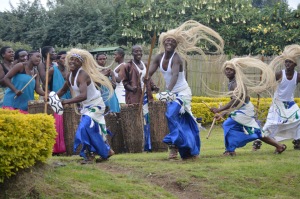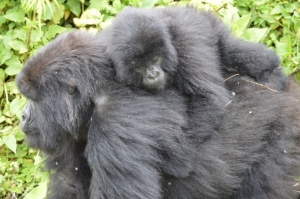As soon as I heard I was going to be working in Rwanda for three months I started trying to think of ways to see the highland gorillas. These are the biggest tourist draw for this small country, which has a really proactive stance on conservation as a result.
It is expensive. For a non-resident permit it is $750 (we benefited slightly from market craziness caused by the US election). However, I felt like this is really one of those things that I feel like a total idiot to miss out on doing when I had a chance – especially since there are only about 800 highland gorillas left in the world.
I very rarely regret things, but I regretted not making the small extra effort to see manta rays in Bali earlier this year. Plus in this case, the fee is an investment in conservation. Not only for gorillas but for the other animals that share their habitat including golden monkeys, buffalo, elephants and birds.
My brother agreed to come out and visit so that we could do it together and that swung it for me. When I told my mum about our plan, she offered to support part of the trip as our joint Christmas present. She’d always wanted to do it herself, and so wanted to experience it vicariously. Thank you mama!
Getting there
To see the gorillas, you have to travel to the Virunga (Volcanoes) national park, just outside Musanze in the northwestern corner that borders on Uganda and DRC.
The trip to Musanze is only two hours by bus or car. We met an amazing guy Alexis at the bus station who was returning to his home and trying to fill the car to pay for petrol so we got a ride with him for the same cost as the bus (1800RWF=£1.80). He even invited us for a drink at his lovely bar restaurant, Green Garden where we met his wife and 4-year-old son. A lovely family. If you are in Musanze, please support their business. You can eat heaps of delicious buffet food for lunch or dinner for about £2 with things like beans, matoke, cassava, ibihaza (pumpkin with beans), saka saka (cassava leaves), ugali, beef stew, fried fish and chicken, spinach and a really yummy potato casserole with peanut sauce.
We stayed in a guesthouse found on Airbnb that was also super cheap and where we were picked up in the morning by our driver at about 6.15am to go out and trek.
Lots of Rwandans back in Kigali were dubious about our decision to go during the rainy season but we lucked out and had perfect weather. I think your trekking permit allows you two attempts to see gorillas if your attempt on the first day is thwarted by rain or you can’t find your group.

The trek
I had heard from some present and past volunteers that the trek could take up to six hours. So I was feeling a bit nervous in the morning.
I was reassured to hear our guide at the briefing say that the oldest person to complete the trek had been 97 years old… until he explained that she was carried all the way up by six porters. With the volcanoes imposing on the skyline I was definitely feeling the adrenaline.
After travelling to the park entrance, we had a briefing about behaviour around the gorillas and the group we were visiting, Amahoro (Peace).
Amahoro is currently a group of 18 that is unusual for having two silverbacks. They are brothers who are two years apart in age. The eldest is dominant, though this is not always the case. There are a range of ages in the group from babies, to teenagers (from about 4yrs old), to blackbacks.
After only about an hour of walking we heard rustling and came across a young gorilla. It was insane! We were urged to continue on as it wasn’t part of the group we were tracking. It was totally surreal. The reason is that the park rangers limit the exposure of each group to humans to one hour per day, to avoid too much contact and over-familiarity. Still was crazy to walk away from a gorilla.
It was only about half an hour later that we found Amahoro. I couldn’t believe that the whole thing was under 90 minutes, and a pretty easy walk. I was expecting to be scrambling up a volcano and struggling up rock faces.

The gorillas of Amahoro group
The hour we spent with the group felt like five minutes. Nothing could really prepare you for what it is like to be in the middle of a family of gorillas watching them playfight, nurse their children and generally chill out.

You are supposed to keep a safe distance from the gorillas, but they will move towards you as they like so there were moments when we were only a foot or so away from them. One baby gorilla came up on us from behind and pushed past Benjamin (my brother) so they actually touched. It was insane.

The dominant silverback was really impressive. A couple of times he did the chest beating thing and charged, which was amazing to see. They are so muscular and powerful and tall. The sound they make before they charge is

It was also amazing to hear them communicating. Gorillas have 12 distinct vocalisations that researchers have documented, that they use for specific situations, like ‘hello’, ‘watch out’, ‘yummy’ etc.

And of course their faces are so expressive. You can see why Dian Fossey got obsessed with them. (On a side note, apparently she went a little bit mad and power crazed living in the jungle and treated other researchers like shit.)

Turns out the reason it was so easy to find Amahoro was because of the season. The recent rains and sunny day meant that bamboo shoots had sprouted all over the lower reaches of the park. Apparently gorillas love these, and can’t help themselves. Hilariously, if they have a lot of them, they get drunk. So we saw a load of half cut young male gorillas acting like fools in the pub on a Friday night. It was pretty funny.
The last gorillas
All in all, an amazing experience. The conservation project that visitors are investing in seems to be effective. Figures from a mountain gorilla ‘census’ will be published next year, and it is expected that they will show that numbers have risen from 880 to almost 1,000.
That is still only 1,000 mountain gorillas – in the whole world! These particular gorillas have suffered from loss of habitat to humans, poaching (Rwanda has armed rangers in the park at all times to prevent this) and disease. I was shocked to learn that more than 5,000 were killed by an Ebola outbreak in the 1990s, at the time 90% of the total population.

All of this makes Rwanda’s homegrown conservation efforts more applaudable. Tourism is carefully managed tourism, and the park well protected. They also have a regular national campaign to get the public engaged around gorillas and the importance of Rwanda protecting them. It’s called ‘kwita izina’, which was the name of a traditional naming ceremony of a child (gorilla mamas usually carry a single baby during pregnancy that lasts nine months, like us). Nowadays it is a month-long public campaign in which schoolchildren nominate names for the mountain gorillas born in the wild that year. After a process of whittling down the names to a winner, a traditional ceremony is held for the naming, which is broadcast on TV.
Rwandan nationals can visit the gorillas for 30,000RWF (£30). However, VSO’s logistics co-ordinator told me that in last years report from the national park, only 14 Rwandans visited gorillas. Considering that that is the entire monthly salary of a primary teacher, it is hardly a surprise.
